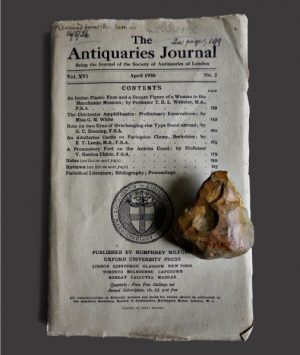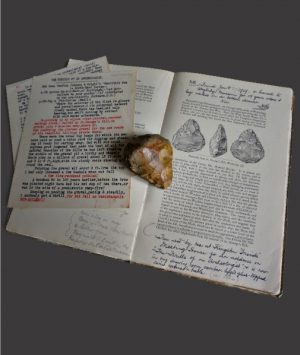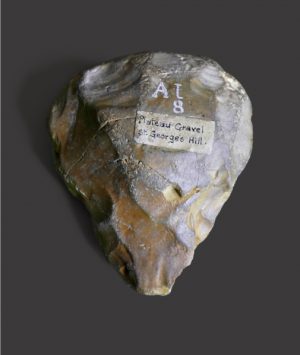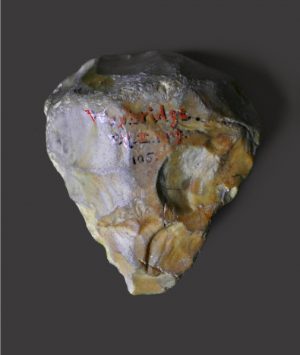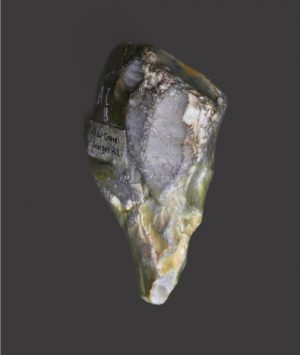Item number: 2924
An Important Very Well Documented British Palaeolithic Flint Hand Axe
From Plateau Gravel, St George’s Hill, Weybridge, Surrey
Discovered by Mr. Howard Brooks on January 27th 1919
Ex Howard Brooks Collection
Ex English Private Collection, Passed by Descent
With a variety of motivating factors, ever since their conception ancient flint tools have been coveted and prized by mankind. In the late 18th Century the pioneering Antiquarian ‘John Frere’ sent two flint hand axes to the Royal Academy in London and in an associated letter famously conveyed his radical interpretation of the finds, concluding that they had been “fabricated and used by a people who had not the use of metals”, in addition, “the situation in which theses weapons were found may tempt us to refer them to a very remote period indeed, even beyond that of the present world”. A view disregarded at the time due to overwhelming conflicting religious beliefs.
During the 19th and early 20th century, a combination of further discoveries, expanding knowledge and understanding of these ancient artefact’s led to extensive collections of hand axes being formed, mainly consisting of finds from gravel pits sourced from workmen eager to supplement their income with the additional pay such discoveries opportuned.
These finds are still being studied and debated, based on much evidence it is now generally accepted that many fine implements had a significance far beyond function, a visual display of the makers knowledge and skill or as a means of conveying the owners social status or power and certainly providing conclusive proof that our ancient ancestors possessed a high degree of culture evidenced in the beautiful reoccurring hand axe forms which are today being reappraised and increasingly appreciated as art in the contemporary world, in addition to their important archaeological significance.
This significant, very unusually well documented hand axe is accompanied by extensive research material. Discovered on 27th January 1919, and marked accordingly in addition to old collection numbers and adhering collection label stating, ‘Plateau Gravel, St Georges Hill’. It was discovered by Mr Howard Brooks while searching the construction site of Walter George Tarrant at St George Hill, Weybridge, Surrey. Quite remarkably the discovery of the Palaeolithic hand axe in-situ, was made within an hour of putting down a book discussing Prehistoric Surrey, the initial source of inspiration to go out searching in the hope of making such a discovery!
The find was initially shown to Archaeologist, Dr Eric Gardner, (1877-1951), founder of Weybridge Museum who visited and enthusiastically examined the exact find spot, (it seems likely that the find is further mentioned somewhere in his published works relating to his research conducted at St Georges Hill). The hand axe was later examined by Mr Reginald, Allender, Smith, (1873-1940), keeper of British and Medieval antiquities at the British Museum, London, who temporarily acquired the axe, arranging for his draughtsman to accurately produce a to-scale illustration to record and publish along with a detailed account and evaluation of the hand axe and discussion relating to its discovery. These works were subsequently published in,’ The Antiquities Journal’, (Mr. Howard Brooks original copy of the book accompanies the hand axe). A number of annotated notes within provide additional insight in to the discovery and events relating to the axe and its movements such as periods of museum loan etc.
The hand axe is further endowed with an extremely rare highly detailed account of the exact circumstances of its discovery in a two page manuscript, prepared by the discoverer, Mr Howard Brooks to be used in a talk he gave on the St Georges Hill hand axe find.
This superb antiquity was discovered along with a number of other outstanding prehistoric tools in an old chest on the point of collapse where they had remained practically untouched, sitting in the same spot in the same room, not seeing the light of day for around one hundred years!
Dimensions (Approximate)
Length: 7cm, Width: 6cm (At widest point)

